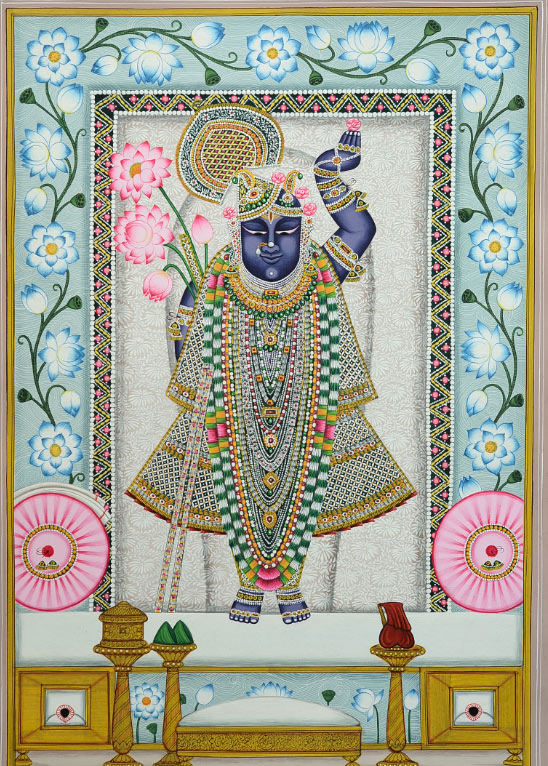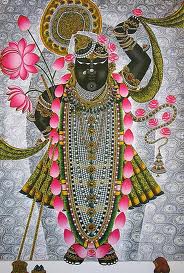
Nathdwara now has pretty much a similar number of unique Pichwai craftsmen as are accepted to have went with Lord Shrinathji on his excursion from Braj to Mewar.
Nathdwara now has pretty much a similar number of unique Pichwai craftsmen as are accepted to have went with Lord Shrinathji on his excursion from Braj to Mewar.
The Fading Temple Art of Nathdwara
AT HALF past five in the sanctuary town of Nathdwara, dairy animals saunter down the avenues in the morning breeze and stop themselves at doorsteps as they anticipate their morning supper. The hints of cowbells, periodic bystanders, and milkmen tinkling without end on bikes blend with the ringing of sanctuary chimes.
Among the various tight paths that grow from the fringe of the Lord Shrinath sanctuary, up left is the generally downplayed Chitrakaron ki gorge (the craftsmen’s road).

Much like the modifying horizon of the seventeenth-century sanctuary town noticeable from Sharma’s 300-year-old housetop, winds of progress have in a horde courses cleared into the lives of specialists like him and his two siblings who serve the Lord through craftsmanship.
Parmanand and his siblings grew up tuning into the story that their progenitors were a piece of a modest bunch of Pichwai craftsman families who came to Nathdwara with Lord Shrinathji from Braj, three centuries back.

Not simply Pichwai specialists, even professionals of Haveli Sangeet – a sort of reverential music that backpedals to the pre-Dhrupad time – and the sanctuary cooks or halwais trust they were a piece of the Lord’s parade that came to Mewar from Braj in the seventeenth century.
Actually, Pichwai implies a scenery. Yet, for the craftsmen of the sanctuary town living the custom, it is a type of workmanship, which frequently streams consistently between the domains of creative ability, expertise, and contemplation.

Pichwai had its causes when specialists, out of dedication, began making backgrounds to portray Lord Shrinathji in various states of mind, settings and seasons. It became over the recent hundreds of years, as experts found Pichwais and took them to their lounge rooms as an illustration of heavenly nature, the same amount of as of extravagance. Be that as it may, with the quantities of recognizing takers winding down, this complicated craftsmanship gets itself set against the more up to date bling types of embellished workmanship which surge the market. Pichwai has come to be the save of a couple.



There are just ten to twelve unique Pichwai craftsmen in Nathdwara now, every one of whom likewise paints the more up to date shapes which are sought after. Indeed, even with a couple of craftsmen who keep on keeping it alive, much has changed in how Pichwai is made. The regular hues utilized before have been supplanted with economically accessible ones. Since the producers of the regular hues did not go down the skill, they have been lost in time.
In a small room on the third floor, Parmanand S Sharma and his siblings, Dev Krishna and Kanhaiya Lal, easily render strokes on a Pichwai being made to a client’s request. The racks behind them are stacked with harsh representations, the sketchbooks of their dad and granddad, moved works of art and old photos. Pichwais basically delineate the Lord in different “Leela‘s” with the moon, lotus blossoms, peacocks, parrots or bovines; and are set in the rich vegetation the specialists find galore in their environment.

“All these are unforgettable to the Lord,” says Sharma. “Pichwais were made by our progenitors in view of the portrayal in the kirtans sung[Listen] by Haveli Sangeet artists inside the Nandlal ki Haveli (Shrinath sanctuary), or in light of what the head cleric narrated to them. They repeated that symbolism, the portrayals were affirmed and at exactly that point painted.”
The fresher embellished craftsmanship is the thing that the more youthful era of craftsmen, similar to Parmanand’s child Neelesh, have taken to for survival. Neelesh whose expertise in Pichwais is restricted says, “It’s hard to make Pichwais, the work is exceptionally many-sided and tedious. What’s more, even after all that exertion there are not really any takers for it since it includes some significant pitfalls very few need to pay. While decorated depictions are sought after and offer like hot cakes.”

A decent Pichwai can take the specialists three to nine months, or even a year, to finish and includes some significant downfalls of Rs at least 50,000. The more established ones, which are a piece of private accumulations, are infrequently accessible available to be purchased and could cost a couple lakh rupees.
In spite of the fact that passing the specialty of Pichwai down the eras is a consistent exchange among the group of craftsmen here, there is an inferred understanding that business craftsmanship is the request of the day. “Stressing over the eventual fate of Pichwai won’t help. We need to take the course of time. We should change with time and paint what offers,” says Neelesh’s uncle Dev Krishna

Pichwai is an essential piece of the rag-bhog-shringar (music, nourishment, and ornamentation offered to the god) custom of a private social gathering called Vallabhas, who take after the Pushti Marg (Path of Grace). While Shrinath sanctuary has a precious gathering, in an atmosphere helpful for a change, louder works of art that are anything but difficult to make and offer are rapidly pushing Pichwais out of the market, hopelessly.
One of the best-known Pichwai specialists of Nathdwara, Raghunandan Sharma, has an enormous feeling of pride flaunting the Pichwais made by his dad and granddad which are currently some portion of the family legacy. The distinction is unmistakably obvious. “They painted with a considerable measure of persistence, thoughtfully,” he says.

He is among the couple of specialists who has a little load of the inestimable characteristic hues made by their ancestors. He utilizes them sparingly, regretting the perpetual loss of the procedure which made them, and battles to get his eight-year-old grandson to realize what he knows. “Along these same lines, soon our eras to come will ask what is Pichwai? What was it like?” he includes.
Nathdwara now has pretty much a similar number of unique Pichwai craftsmen as are accepted to have gone with Lord Shrinathji on his excursion from Braj to Mewar.
Edited By articlesworldbank.com
